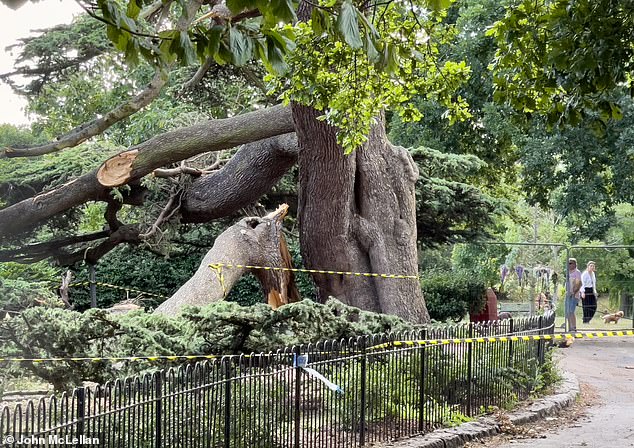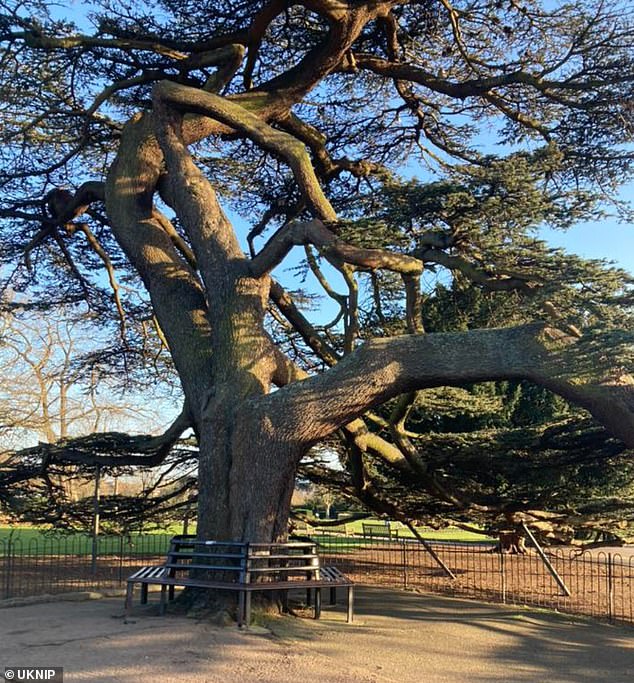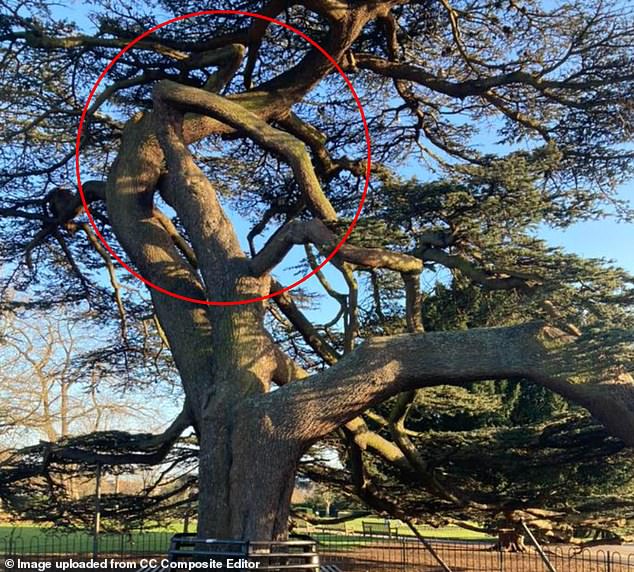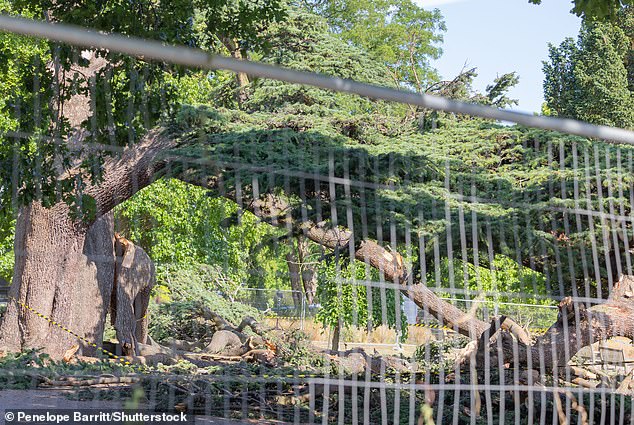The old cedar of Lebanon in Southend’s Chalkwell Park had already been standing for more than 350 years when, shortly after the end of the First World War, a photographer snapped a group of children sitting on the iron bench which then encircled it.
In the background of the picture postcard he produced, it’s just possible to make out wooden struts that, more than a century ago, were propping up the much-loved tree’s vast horizontal limbs.
Believed to have been taken in 1919, the image serves as a poignant reminder of the many generations who played or sheltered beneath the cedar’s giant canopy, long before it partially collapsed last Saturday with such tragic consequences.
Some of them came to lay flowers in the park this week, setting them down just a few metres from the spot where seven-year-old Leonna Ruka lost her life.
Her six-year-old cousin is still critically ill in hospital as a result of this shocking incident. Three other youngsters, caught by smaller branches, escaped with minor injuries.
It was, say those who witnessed dozens of frantic adults trying to lift the heavy tree branches off the stricken children, a scene of absolute trauma which came out of the blue, in the middle of what up until that moment had been a fun-filled summer’s day.
The Victorian park was full of families, many having picnics while their children played. Some had come to watch the local cricket team, Westcliff, play at their club on the edge of the open space.
The club’s players were among those seen frantically racing towards the tree when it fell.

Seven-year-old Leonna Ruka lost her life when the old cedar of Lebanon in Southend’s Chalkwell Park collapsed on to her and four other children playing below its thick branches
One witness told the Mail he would ‘never forget the screams’ of the children involved. ‘People are deeply affected by what happened,’ says 54-year-old Adam Ramet, who rode a trike under the cedar as a child and used to bring his own daughter to play beneath its low branches.
‘The cedar has been a big strong presence that’s just always been there, it sits in all our childhood memories. For this terrible tragedy to have come from that tree is almost unthinkable. People are grieving for the little girl who lost her life and shocked because they know it could so easily have been them or their own kids.’
Despite much speculation about the metal struts –which years ago replaced the old wooden ones – holding up the large, horizontal lower limbs of the tree, it was the cedar’s crown, which for years had grown out at an angle to the trunk, which suddenly tore away and fell from around 20ft with such tragic consequences.
‘The struts have been there as long as I can remember,’ says Mr Ramet, ‘and you could see very clearly that it was the top of the tree that had sheared off sideways and come crashing down.’
This week, experts indicated to the Mail that while fatalities from fallen trees are mercifully rare – five or six every year across the UK according to Health and Safety Executive (HSE) figures – a hot summer’s afternoon is the most likely time for such a tragedy.
The collapse of the cedar happened just before 3pm in the middle of a heatwave. Arboriculturalists have pointed to a phenomenon called Sudden Branch Drop (SBD) – the unexpected collapse of mature tree branches during a prolonged dry period where there is no other obvious defect or cause.
It is a condition which particularly affects large tree species including cedars, which can otherwise live for a thousand years and is more likely to happen in the afternoon, when trees experience the peak of transpiration – water loss through leaves –and the highest temperatures which can weaken branches. It is often preceded by a loud cracking sound.
Last Saturday, dozens of eyewitnesses heard a horrendous crack before the screams which followed a second later. John Fryer, managing director of JF Tree Specialists, said this week that SBDS should not be discounted by those investigating last weekend’s tragedy.

Dozens of frantic adults tried to lift the heavy tree branches off the stricken children in the middle of what up until that moment had been a fun-filled summer’s day
‘On hot still days, internal moisture stress [when the tree is losing more water than it’s taking in through its roots] or hidden cracks can make otherwise healthy-looking limbs – or entire trees – fail without warning.’
Writing on Linked- In this week, environmental consultancy ProHort added that the tragedy underlined the importance of tree health surveys which it recommends are carried out every two years, or more frequently in high-risk or high-traffic areas.
This week, amid questions as to whether anything could have been done to prevent the tragedy and with an investigation underway by Essex Police, assisted by the HSE which has also visited the site, the cedar was cordoned off and concealed from view with a metal fence.
An ever-growing carpet of flowers, teddy bears and cards at the heart of Chalkwell Park is a heartbreaking reminder of the terrible price paid by Leonna’s parents for what the HSE say is a one in ten million occurrence.
Southend-on-Sea City Council is responsible for around 30,000 trees including those in its parks. Safety assessments are based on guidelines drawn up for its Tree Policy 2020-2030, carried out by one of its three arboricultural officers and recorded on a tree management database. According to the policy, there is a need to ‘inspect trees in or near public places or adjacent to buildings or working areas to assess whether they represent a risk to life or property and to take remedial action as appropriate’.
Southend tree inspectors use the nationally recommended ‘visual tree assessment’ method which involves examining roots, trunk, branches and crown, looking for signs of decay, cracks or other structural issues.
Potential defects can be investigated in more depth using sonar equipment or other decay detection tools.
Because of the police investigation into last week’s fatality, the council will not confirm when the Chalkwell Park cedar was last inspected or whether its position next to a main footpath meant it required extra checks.

The ancient tree encircled by a bench as it looked in the years before its collapse. The branches had been propped up by supports for decades

Circled, the branch of the centuries old cedar of Lebanon that broke off and killed Leonna and seriously injured her six-year-old cousin
The norm for council-owned trees in parks across the UK is every three to five years, with trees within falling distance of play areas or those deemed high risk, often checked annually. Additional ‘reactive’ checks are carried out if and when parks staff raise concerns.
The Chalkwell cedar is believed to have been growing since the middle of the 17th century when England was in the throes of civil war.
The park, which opened in 1901, was built on the site of a 14th-century manor and farmland which once stretched to the sea. Southend Council bought the land in 1899.
Local history books detail how, from the day it opened, children loved to play around the cedar. Even a century ago, its thick horizontal branches appeared to defy gravity.
According to one source who spoke to the Mail this week, the cedar’s inspections were up to date but parks staff were reported to have been seen examining it as recently as a fortnight ago.
Even when part of a tree is deemed to be defective, the council will review whether it can be safely retained.
With local authorities under immense pressure to promote trees and increase their number because of the vast benefits they provide to society, the onus is often on retention rather than removal.
Southend Green Councillor Richard Longstaff, who is also a member of Once Upon A Tree – a group dedicated to the protection and replanting of trees – told the Mail: ‘The council only has to talk about removing a tree and there’s a public backlash.

An ever-growing carpet of floral tributes and teddy bears left by locals near to where the tragedy happened

The now fenced-off cedar was regarded as the ‘centrepiece’ of the park
People are up in arms because trees bring such so much benefit to towns and cities. It’s a hard balance to strike between looking after trees and ensuring safety. Historically, Southend Council has been very, very good at managing trees and dangerous trees. They won’t hesitate if there’s a problem with a tree and it needs to be done.’
Mr Longstaff, who takes his own three children to the park, said the old cedar was regarded as the ‘centrepiece’ of Chalkwell Park and last Saturday’s tragedy was ‘heart wrenching’. He added: ‘The question for most councils is how do we anticipate this particular risk of Sudden Branch Drop and make our veteran trees safer without just removing them all? It’s about a balanced conversation between risk and benefit.’
The National Tree Safety Group, formed in 2007 because of concerns that lack of clear guidance about tree safety, promotes what it calls ‘common sense risk management’ that is ‘proportionate to the actual risks from trees’.
‘Very few of us ever experience the tragic consequences of a fatality or a serious injury as a result of tree failure,’ says the group’s latest guidance, which was produced amid concerns that safety fears were leading to the unnecessary felling of too many trees.’
But the guidance also warns that ‘in those rare incidents where serious and even fatal tree-related accidents occur, they will be investigated and may result in litigation.’
The HSE can only issue fines and penalties to those who breach health and safety law, so compensation claims must be pursued separately through the civil courts.
In November last year it fined Chester East Council £500,000 after 48-year-old Christopher Hall from Wilmslow was killed by a falling bough from a lime tree while walking his dog in one of the town’s parks on a dry and warm day in August 2020.
It emerged that less than a year earlier, another large bough had fallen from the same tree but no investigation was carried out by the council or its ground maintenance company to see if it posed a future risk.
In 2023, Newcastle City Council was fined £280,000 after a six-year-old girl, Ella Henderson, was killed by a falling willow tree in her school playground.
A bi-annual inspection five years earlier had called for ‘further investigation’ of the tree but this advice was not passed on. The council admitted breaching safety laws over her death.
Sudden Branch Drop was discussed by horticulturalists after the death of Erena Wilson, 31, at Kew Gardens in 2012 after a large branch fell on her from another cedar of Lebanon which had been planted in 1759 when the gardens first opened.
Staff at Kew believed the branch fall, likened to a ‘lightning crack’ by one onlooker, was due to a combination of wind and rain and was a ‘terrible freak accident’ while another expert told her inquest ‘it was definitely summer branch drop’.
In the end, the jury returned a verdict of accidental death stating ‘there is insufficient evidence to establish the cause of the branch failure’.
Even so, Erena’s father called for branch drop warning in parks and public gardens and further research into what is still a little understood phenomenon.
Essex Police said yesterday that no arrests or charges have so far been made and that ‘our enquiries continue’.
For now the park remains a place of unimaginable sadness, above all, of course, for Leonna’s family who had travelled from their home in Dagenham, Essex, last Saturday. ‘She was a light in our lives and in the lives of everyone who had the joy of meeting her,’ her parents said in a statement this week.
Whether or not Leonna’s death could have, or should have, been prevented remains to be seen.












